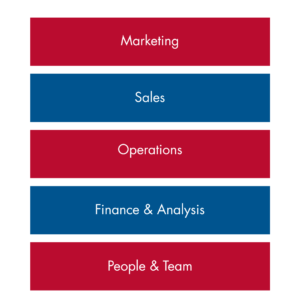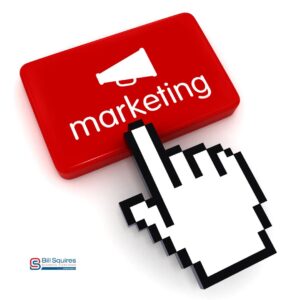 The Five Box Model is a way of looking at a business through five critical areas: marketing, sales, delivery, operations and finance. Each box connects to the others, but the sequence starts with marketing. After all, without a steady flow of leads coming into the business, nothing else can happen.
The Five Box Model is a way of looking at a business through five critical areas: marketing, sales, delivery, operations and finance. Each box connects to the others, but the sequence starts with marketing. After all, without a steady flow of leads coming into the business, nothing else can happen.
When we talk about the marketing in the Five Box Model, it all comes down to one simple objective and that’s generating leads. Marketing’s job is to bring people to your door who are ready and willing to buy. That’s it.
In the picture of a ‘perfect business,’ marketing looks like this:
- The phone never stops ringing
- Your inbox is always full of enquiries
- There’s a queue ten miles long outside your office of ideal clients waiting for you to serve them
Effective marketing delivers a constant stream of qualified leads that are lining up to work with you. That’s the ultimate measure of successful marketing.
Start with one strategy and do it well
It’s easy to feel overwhelmed by the sheer number of possible marketing strategies. Social media, paid ads, SEO, events, referrals, PR, email campaigns – the list goes on. But the biggest mistake business owners make is trying to do everything at once.
Don’t start with ten things and spread yourself thin. Start with one. Do it properly. Test, measure and refine until it’s working at its best. Only then should you add another.
The goal is to build what I call a ‘10×10.’ That’s ten different strategies all working well, all generating leads. But you don’t need to start there. Build one at a time.
Measure what matters
Marketing without measurement is like driving blindfolded. You might be moving fast, but you’ve no idea if you’re heading in the right direction!
The first numbers to look at are:
- Leads by source – where are your enquiries actually coming from?
- Cost per lead by source – how much are you spending to generate each one?
But the analysis can’t stop there. Generating lots of leads isn’t enough if they don’t convert into paying clients. That’s where marketing meets the next box. Sales.
If you’ve got one channel producing huge numbers of leads but your conversion rate is low, your client acquisition cost goes through the roof. You’re tying up resources chasing unqualified prospects. So don’t just measure leads. Measure conversion and profitability too.
This is why marketing can never be looked at in isolation. It’s the start of the pipeline, but unless you’re tracking the whole flow from marketing into sales and beyond, you’ll be focusing on the wrong thing.
Optimise before you expand
Once you’ve identified what’s working, double down. Ask the key questions:
- What’s working well?
- How do we make it work better?
- What can we test to improve the results further?
Optimisation is an ongoing process. It’s not about throwing new tactics at the wall. It’s about improving the return on what you’re already doing before layering on the next strategy. Only when your current activity is running effectively should you bring in a new approach to test.
Keep testing and measuring
Ultimately, marketing isn’t a one-time project. It’s a continuous cycle of:
- Choosing a strategy
- Executing it well
- Testing and measuring the results
- Optimising what works
- Adding new strategies over time
The businesses that thrive are the ones that stay disciplined about this process. They don’t chase every shiny new idea. They build strong foundations, measure what matters. They’re the businesses that adapt as the landscape shifts.
The next shift in marketing is from SEO to AI
 For years, the focus in digital marketing was simple – how to rank on Google. Search engine optimisation (SEO) became the battleground. But the way people search is changing fast.
For years, the focus in digital marketing was simple – how to rank on Google. Search engine optimisation (SEO) became the battleground. But the way people search is changing fast.
Today, when someone wants an answer, they don’t necessarily type in a query and trawl through a list of results. Increasingly, they’re asking AI tools directly or using Google’s own AI-generated snippets that appear right at the top of the search page. With one click, the answer is there. No scrolling. No digging. No visiting five different websites.
This changes the game. If your business isn’t showing up in those AI-powered answers, you’re invisible.
These AI snippets are where Google and other platforms pull a concise, ‘best possible’ answer straight from a source they trust. Instead of competing for position one, two or three on Google, you’re competing for the single AI-generated response. And if you win that spot, you’re getting both visibility and authority. You become the trusted voice that AI itself points people towards.
This is why it’s now more essential than ever to be marketing for AI. Traditional SEO isn’t enough. The question for every business owner should be whether they’re creating the kind of content AI wants to show. That means being clear, concise and brutally helpful. It means answering the exact questions your customers are asking. In plain English.
The winners of the next phase of marketing will be the businesses who stop thinking about keywords alone and start thinking about how AI models interpret and deliver answers. Because if you’re not appearing in those AI snippets, your competitors will be.
Endless leads alone won’t build your business
The good news is that the opportunities have never been greater. Whether it’s inbound content, referrals, AI-driven visibility or good old-fashioned networking, there are more ways than ever to fill your pipeline.
The challenge is focus. Do one thing well. Measure it. Optimise it. Then add the next. Over time, you’ll build a marketing engine that doesn’t just keep the phone ringing – it creates the queue of clients waiting to work with you.
Marketing is only ever the starting point. You can have a ten-mile queue of leads outside your door, but if you can’t convert them into paying customers, you don’t have a business, you have a bottleneck. That’s why the next box in the model is sales. In the next blog, we’ll dive into how to turn opportunity into revenue, and how to build a sales process that works every time.




